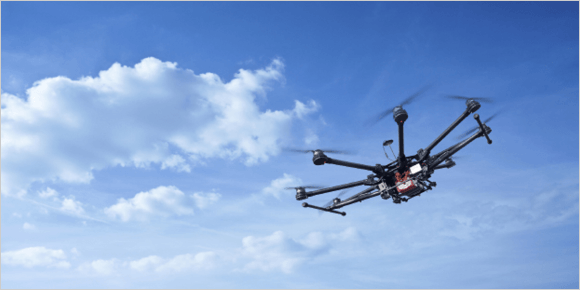Drone technology offers a competitive edge, but presents legal challenges.
By David Tobenkin
The potential for using drone technology to improve the presentation of properties and add value in additional areas is sky high, but at least at present, so are the regulatory and legal challenges of doing so, say REALTORS® who are using the technology to promote their properties.
Ann Buchanan, a REALTOR® at Keller Williams Realty, says her 73-acre hunting property listing in Sumner County, Tennessee, stalled on the market for seven months but sold within two weeks after she added drone footage showing trails, vegetation and other property attributes. “I think it helped,” Buchanan says. “Drone footage is a big step up from normal pictures of the house and rooms, and in this case, it was difficult to display an expansive property like this adequately without drone footage.”
Preflight Checklist
However, use of unmanned aircraft systems (UAS), or drones, for commercial purposes, including the marketing of real estate, requires authorization from the Federal Aviation Administration (FAA) via a Section 333 exemption, notes an FAA spokesperson. That presents important questions for REALTORS® who wish to use drone footage.
Those who wish to obtain a waiver must file a petition of exemption with the FAA, and must meet a variety of conditions, including demonstrating that the petitioner has at least an FAA sport/recreational pilot’s license. The FAA advises that Section 333 petitioners should allow up to 120 days after submission for a decision to be made on a petition of exemption, though it says that decisions since mid-2015 are now tending to be made more swiftly.
Use of a third party, such as a drone-operating video production company, to take drone footage is the second way to obtain footage. However, that individual should have a section 333 waiver from the FAA, says a National Association of REALTOR® (NAR) spokeswoman.
The potential penalties for unauthorized drone use are $10,000 per flight. The FAA actively investigates reports of unauthorized drone use and, as a first step, will often send educational letters to those it believes have engaged in unauthorized use. One REALTOR® in San Antonio says he used his own drones to generate video footage of his properties from 2013 until he was investigated by FAA agents after competitors reported his drone use to the FAA in July 2015.
After the FAA warned him of potential fines for continued commercial drone use, the REALTOR® says that he ceased flying drones and sought a Section 333 exemption, which he obtained in December. But even after receiving the exemption, he says that he has not resumed using drones commercially due to the onerous terms imposed by the exemption letter he received. “Even after being certified, the letter requires us to provide 40 hours prior notice of our intent to collect aerial footage, a description of where we plan to collect it, approval of a flight log by the FAA, and subsequent logging of where we flew,” says the broker. “Our exemption has 32 different demands to be met each time we fly. It’s ridiculous.”
The authorizations and conditions vary by exemption letter, those interviewed say. Jeff Galindo, a Las Vegas-based REALTOR® and principal broker at Real Estate Strategies, LLC, who in April 2015 was granted a section 333 exemption, says as an experienced, licensed pilot, his exemption contained far fewer requirements and did not, for example, require the filing of flight plans.

Aerial view of Fort Collins, Colorado, shot from a low flying drone. Images taken from a drone can yield unique perspectives of a property that are not available with traditional land-based photography.
The View from Above
FAA requirements to use drones commercially could change significantly later this year, when the FAA is expected to issue final rules regarding commercial UAS use. In February 2015, the FAA proposed rules that would allow the use of small drones for non-recreational purposes.
Under the proposed rule, the person actually flying a small UAS would be an operator. An operator would have to be at least 17 years old, pass an aeronautical knowledge test and obtain an FAA UAS operator certificate. To maintain certification, the operator would have to pass the FAA knowledge tests every 24 months. A small UAS operator would not need any further private pilot certifications (i.e., a private pilot license or medical rating). When operating the drone, the operator would be required to maintain a visual line of sight of the drone.
There is no guarantee, however, that the final rules, which the FAA says could be issued by late spring 2016, will contain those provisions.
FAA rules are not the only legal issues presented by drone use. States and cities can also impose limitations upon the manner in which drones are used. The challenges often vary by location: using drones to take footage in crowded urban settings is likely to be more difficult than doing so in a rural location. Other FAA rules also may limit use of drones in certain areas—there is a 30-mile no-fly zone around Washington, D.C., for example.
Send in the Drones?
So you want to generate your own drone footage?
Currently, the major barrier is the time and cost of obtaining a pilot’s license. After achieving that, one REALTOR® says it took him and his partner five hours to prepare a section 333 application, which was submitted online through regulations.gov at no cost.
A wide variety of drones are available for purchase, with capabilities increasing and prices falling as their penetration increases. A model for $1,300 or so will likely contain all the technical capabilities a REALTOR® will need and will include the camera.
REALTORS® say that the more challenging aspect of drone use is the last step—generating polished video content. While obtaining the basic video is not difficult, editing and enhancing raw footage to derive professional-looking final footage may be prohibitively time-consuming or expensive, especially for those who do not already have those capabilities, such as video editing software like Apple’s Final Cut or Adobe’s Premiere.
In addition, there are obvious liability issues presented, such as injuring third parties or their property through off-target drones. Realty professionals will want to ensure that their business liability policy covers drone use if they wish to operate a drone, and should ensure that a third party who takes drone footage for them is covered by insurance and, ideally, names them as an additional insured.
Even privacy issues are posed by drone use. The San Antonio REALTOR® says a colleague in his market has been sued for displaying drone footage that included identifiable photography of the neighbor of the listed property.
Flight Plan
While the challenges abound, the potential upside for using drone footage makes overcoming those challenges very attractive. Buchanan notes that she has often used drone footage to display the neighborhood of a listing as well as the property itself. She says she may expand that to include footage of the amenities of the larger community. Galindo uses drone footage for a minority of properties and absorbs the cost of the footage himself, rather than passing it along to customers. He says he foresees a future in which drone technology will allow REALTORS® to offer a host of services beyond showing property amenities to potential buyers. For instance, drones employing infrared imaging to measure property energy efficiency could assist in home inspections for difficult locations, such as roofs, and to evaluate other home systems. “It will enhance the value of products used in home production today,” Galindo says.
Even when the FAA final rules are approved, an NAR spokeswoman says she foresees that most REALTORS® will use third-party drone operators for footage because they will be more efficient and skilled at taking the footage and processing it. Buchanan says she paid an extra $150 to her photographer on top of standard fees of $110 to $175 for drone-shot video footage. The San Antonio REALTOR® says that he still hopes to eventually use his drone because after the fixed costs of obtaining his license and buying the drone, it would cost him a fraction of the $600 per listing he estimates he would pay a third party to do it himself.
NAR has vigorously supported greater REALTOR® ability to use drones in their businesses. “Drone technology offers a tremendous opportunity for the business of real estate and the broader economy,” says NAR President Tom Salomone in a statement. “That’s why NAR continues to support the integration of drones into the National Airspace and a regulatory landscape that allows for the responsible commercial use of drones. We will continue working with the FAA and our industry partners to keep safety and privacy at the front of the conversation and ensure a clear path for REALTORS® to take advantage of this technology.”
Learn more about FAA rules and regulations on drone use.








